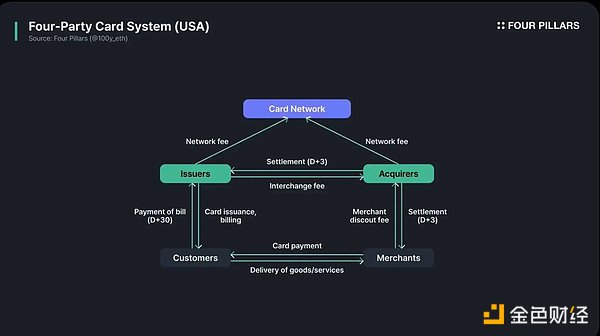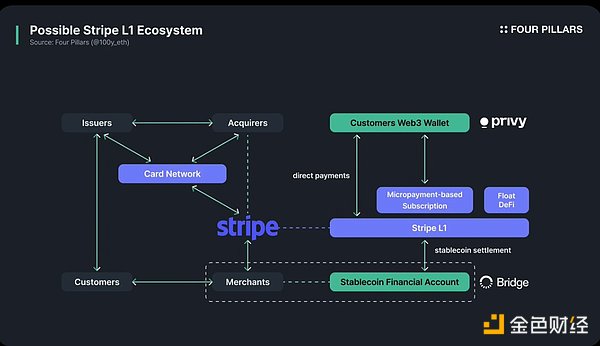Author: 100y.eth Source: X, @100y_eth Translation: Shan Ouba, Golden Finance
Key Points
There are rumors in the crypto community that Stripe may launch its own L1 blockchain network. Considering its recent acquisitions of Bridge and Privy, launching its own blockchain may indeed be the next step.
Stripe is a leading global payment service provider (PSP), playing an important role in connecting merchants, acquiring banks, card networks and issuing banks at the technical level to ensure smooth and secure transactions.
If Stripe really wants to launch an L1, the conservative expectation is to support the use of stablecoins and integrate Stripe L1 into customer payment and merchant settlement processes. In the optimistic case, it may completely transform the payment system and achieve the following: 1. Allow payments to bypass traditional issuing banks and card networks and support direct payments; 2. Enable micro-subscription streaming payments that are impossible in traditional systems; 3. Generate income on short-term deposit balances on Stripe L1.
Currently Stripe mainly operates as a payment gateway and acquiring bank, but the potential Stripe L1 is expected to allow the company to assume the role traditionally played by issuing banks and card networks, which will be a major milestone in the history of the payment industry.
Will Stripe really release L1?
Recently, rumors have emerged in the crypto community that Stripe (a global payment infrastructure giant) plans to launch an L1 blockchain. There is also a saying that venture capital firm Paradigm has recently secretly recruited for a portfolio project, which some people speculate is in preparation for Stripe L1.
At present, except for insiders, no one can be sure whether Stripe will really release L1. But considering the recent surge in interest in the blockchain and stablecoin fields in the traditional financial circles of the United States, card network companies such as Visa and Mastercard are also accelerating blockchain integration, and Robinhood announced plans to tokenize stocks through Arbitrum-these backgrounds make the rumor that "Stripe is going to release L1" enough to arouse the community's high attention.
Stripe's mission is to "make the GDP of the Internet bigger." The company focuses on building global economic infrastructure to help businesses of all sizes (from startups to large enterprises) manage payments, business and growth online. From this perspective, blockchain is very attractive to Stripe.
In fact, Stripe has been actively expanding its blockchain-related business recently. In February 2025, Stripe acquired the stablecoin infrastructure company Bridge (@Stablecoin) for approximately US$1.1 billion, strategically consolidating its position in the field of stablecoin financial infrastructure. Based on this acquisition, Stripe launched its Stablecoin Financial Accounts service at the Stripe Sessions event in May 2025.
The service is available in 101 countries around the world, enabling businesses to:
Hold USDC issued by Circle and USDB issued by Bridge
Deposit and withdraw stablecoins through ACH/wire transfers for US dollars or SEPA transfers for euros
Deposit and withdraw USDC on the following blockchains: Arbitrum, Avalanche C-Chain, Base, Ethereum, Optimism, Polygon, Solana and Stellar
This means that businesses in 101 countries can easily obtain US dollar-denominated stablecoins through Stripe and seamlessly integrate into the traditional banking system to enable convenient deposits, withdrawals and payments in US dollars.
In addition, in June 2025, Stripe acquired @privy_io, a Web3 wallet infrastructure startup that supports wallet creation, transaction signing, key management, and Gas abstraction via email or single sign-on (SSO).
Combined with these actions, the rumors that Stripe may release L1 to expand its blockchain business are not groundless. In other words, Stripe now has stablecoin infrastructure and wallet infrastructure, and launching a blockchain network that can create synergies with these services will become a natural next step.
2. What would it look like if Stripe really launched the L1 network?
Of course, there is currently no solid evidence that Stripe will release L1. This is just a rumor at the moment. Nevertheless, we can still reasonably imagine how Stripe might be used and what services it could enable that were previously unavailable if it were to launch its own L1 blockchain. The following is just my personal imagination, please take it easy and treat it as a brain hole of "Oh, so blockchain can be used in payment services like this."
2.1 Stripe as a PSP

Before discussing what improvements blockchain can bring, we must first understand what services Stripe currently provides. Stripe is the world's most well-known PSP (payment service provider). PSP acts as a technical bridge between merchants, acquiring banks, card networks and issuing banks to ensure a smooth and secure payment process. Specifically, Stripe's current roles include:
Payment Gateway: When customers pay with bank cards online or offline, Stripe is responsible for securely collecting card information, encrypting it and transmitting it to the card network and issuing bank.
Multi-payment method support: Stripe integrates multiple payment methods including credit cards, digital wallets, bank transfers, local payment methods, etc., making it easy for merchants and customers to use.
Fraud detection and security: Stripe uses machine learning-based fraud detection systems and security standards such as PCI-DSS to prevent fraudulent transactions.
Multi-currency and international payment support: Automatically handle exchange rate conversions between multiple currencies to facilitate merchants to conduct international sales.
Reporting and analysis: Provide merchants with detailed transaction history, success rate and customer behavior analysis to help optimize business operations.
Technical integration and operational support: Through APIs and SDKs, merchants can easily build payment systems and handle operational matters such as customer support, compliance, refunds, and bill management.
Customer experience optimization: Provide a fast and smooth payment process, supporting diversified scenarios such as subscriptions, installments, and refunds.
Merchant Settlement Intermediary: As a PSP, Stripe will cooperate with the acquiring bank or directly act as the acquiring bank to settle the funds received from the issuing bank to the merchant.
If there is no such role as PSP, merchants must support various payment methods on their own and sign contracts with different acquiring banks one by one, which will greatly reduce the experience of both merchants and customers.
2.2 Possible changes brought by Stripe L1

If Stripe really launches the L1 blockchain, how can it improve existing services and what new features can it achieve? Here are some ideas I came up with:
2.2.1 Conservative scenario
Stripe L1 integrates with merchant stablecoin financial accounts
Currently, Stripe has provided stablecoin financial accounts to merchants in 101 countries, allowing them to hold USDC and USDB stablecoins and deposit and withdraw through traditional banking systems (ACH, SEPA, etc.) or various blockchain networks.
If Stripe launches its own L1, it can be expected that these stablecoin accounts will also support deposits and withdrawals through Stripe L1. At the same time, merchants can also use their stablecoin balances on Stripe L1 to carry out more financial activities.
Stablecoin Settlement Options for Merchants
As a PSP, Stripe currently either works with acquiring banks or acts as an acquiring bank to settle merchant sales revenue to merchants. With Stripe L1, merchants may choose to settle with stablecoins based on US dollars. This will be a huge benefit for merchants who have high demand for US dollars but limited access to US dollars.
Wallet Services for Customers
Stripe recently acquired Privy, a company that provides infrastructure that makes it very easy for users to create and use wallets. Although Stripe mainly serves merchants and enterprises and does not currently provide wallet services to individual users, if Stripe L1 uses Privy's technology, it will be possible for individual users to easily create Web3 wallets on Stripe L1, pay with stablecoins, and participate in various financial activities in the Stripe L1 ecosystem.
Stablecoin payment options for customers
Currently, online payments through Stripe still rely on bank cards, bank accounts and other traditional methods. With Stripe L1, users may be able to link their own Web3 wallets (whether provided by Stripe itself or by a third party) and choose stablecoins as a means of payment.
2.2.2 Bull Case
Direct payments between customers and merchants
In traditional payment systems that use credit cards or bank accounts, both customers and merchants must rely on existing financial networks (card networks and banks). But if Stripe L1 allows customers to pay merchants directly with stablecoins, it can bypass the issuing banks and card networks, greatly increase settlement speed and reduce fees. Of course, since payments on the blockchain are more difficult to reverse or refund, corresponding protection mechanisms need to be designed.
Support micropayment-based subscription services
Blockchain can achieve micropayments and streaming subscriptions that traditional systems cannot do. Most subscriptions on Stripe are now automatically renewed on a monthly or annual basis, but with Stripe L1, it is possible to achieve real-time billing by the minute or even more granular. Users will pay strictly on demand based on actual usage, and all payments can also be automatically processed by smart contracts. This new subscription model can give birth to many new services based on it.
DeFi utilization of short-term deposited funds
The delayed settlement in the current payment system is mainly to deal with problems such as fraud, cancellation or refund. Therefore, even if Stripe L1 enables direct stablecoin payments from customers to merchants, in actual operations, these funds are likely to be temporarily managed on Stripe L1 instead of being released to merchants immediately.
The scale of these short-term deposited funds may be very considerable and can become a huge liquidity pool for Stripe L1. For example, these funds can be provided as liquidity to DeFi protocols, put into the lending market, or invested in bonds to earn interest, thereby significantly improving the efficiency of fund use.
3. Final Thoughts
After studying stablecoins for a long time and observing the entire industry and ecosystem, I think the rumor that "Stripe is going to launch L1" is indeed very intriguing. So far, payment companies like Visa, Mastercard, and PayPal have basically just treated blockchain and stablecoins as additional features. If Stripe really launches its own L1, this may be a historic moment in the paradigm shift of the payment system.
Stripe's main role has always been a payment gateway or acquirer, but if Stripe L1 is introduced, it may play the role of both a card network and an issuing bank. In addition, it can improve payment efficiency through blockchain and undertake functions that were previously impossible to achieve, such as streaming subscriptions based on micropayments and automated management of short-term deposited funds.
We are standing on the threshold of an era of disruptive innovation in the payment system driven by blockchain. As for whether Stripe will really launch L1 as rumored, it remains to be verified by time.
 Hui Xin
Hui Xin
 Hui Xin
Hui Xin Jasper
Jasper Catherine
Catherine Brian
Brian Jixu
Jixu Joy
Joy Jasper
Jasper Davin
Davin YouQuan
YouQuan Aaron
Aaron